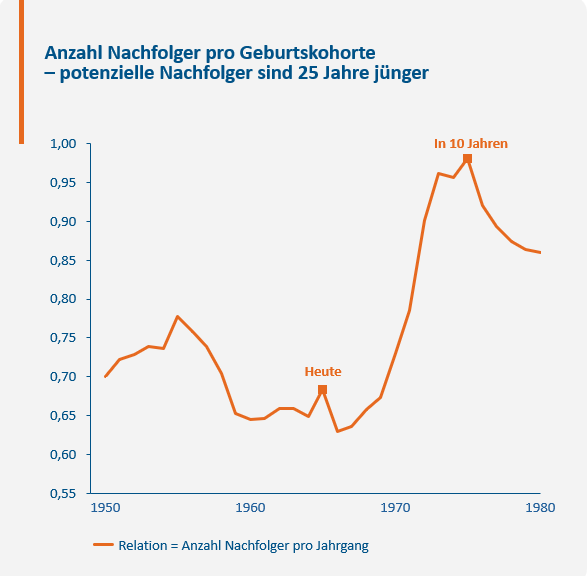In the next ten years, thousands of companies will be unable to find a successor. While the demographic gap between the outgoing and incoming generations currently plays a significant role in unsuccessful succession planning, this gap will largely close again in the coming years. However, the much-discussed succession problem is not solely due to demographic change. Other influencing factors such as the sustainability of the business model, company size, and individual succession capacity are at least as crucial.
The influence of demographic change and other factors on company succession

1. The demographic gap has never been greater, but it is only temporary
Currently, for every ten entrepreneurs of the 1965 generation, there are only around seven potential successors of the 1990 generation. This unfavorable ratio of 0.7 is a key reason why many companies today cannot find a suitable successor. Micro and small businesses are particularly affected, where orderly succession is often difficult for other reasons as well.
As part of our research, we conducted an analysis in which we examined birth cohorts, generational change, and their long-term effects on the succession landscape. The results provide interesting and sometimes surprising insights for understanding current market dynamics. We based our analysis on the following assumptions: Entrepreneurial responsibility is exercised for an average of around 25 years. Business succession typically occurs around the age of 60, while potential successors are on average 25 years younger.
While a total of around 13 million children were born in the decade between 1960 and 1970, the number fell to just 8.5 million between 1985 and 1994 – 25 years later. This corresponds to an average ratio of 0.6.
From 1970 to 1980, only 8.5 million children were born, while in the successor cohort 25 years later (1995 to 2004), the number was 7.6 million. The ratio improves to an average of 0.9.
For the sixty-year-olds in 2035 (born in 1975), who are expected to retire from their business in ten years, a similarly large cohort of 35-year-olds (born in 2000) will be available as potential successors. This means that there will be one successor for every entrepreneur willing to hand over the business.
Afterward, however, the ratio will deteriorate slightly again.
What concrete implications does the demographic gap that will continue to exist in the coming years have for companies?
2. Particularly affected: Micro and small businesses
In Germany, there are around 3.1 million registered businesses. Around 85% of these generate less than €1 million in revenue, while approximately 98% of all businesses have revenues below €10 million.
Micro and small businesses are particularly affected by the succession problem. Many of these businesses currently barely provide their owners with a sufficient income – in many cases, the entrepreneurial salary is below what could be earned in a qualified permanent position. In addition, there is a high degree of personal dependency, poorly scalable business models, and little differentiation. We therefore expect that many such businesses will not be able to continue operating and will disappear from the market.
Even for small but fundamentally profitable businesses – such as skilled trades – succession planning is often difficult. While these businesses are financially sound, there is a lack of suitable, motivated successors. The combination of the demands on professional expertise and entrepreneurial responsibility deters many potential successors.
3. Successful business succession requires not only quantity, but the right “spirit”
In our view, business succession is more than just a demographic issue. Successful succession requires future entrepreneurs to be willing to assume responsibility, take risks, and actively shape the future. Studies show that successors must not only manage the company, but also understand and further develop the “identity within the company.” This requires far more than specialist knowledge. It requires entrepreneurial spirit, courage, and a clear understanding of how to combine tradition and innovation.
Especially in family businesses, succession is closely linked to emotional, cultural, and normative issues. It’s not just about taking over businesses, but also about developing them and aligning them with new challenges. The willingness to see oneself as an entrepreneur does not arise automatically; it must be fostered through creative freedom, trust, and a culture of openness to mistakes.
Succession is always also a question of attitude and culture. Those who understand entrepreneurship as a creative task and are supported in this role by those around them can take on responsibility and actively develop the company. This success is achieved when the entrepreneurial spirit of the next generation is fostered, when trust is established, when creative freedom is created, and when the outgoing generation is willing to embrace change.
4. Larger companies: Succession planning is often addressed too late
For medium-sized and larger companies (with revenues of approximately €10 million or more), the situation appears better at first glance. These companies have better structures, are less dependent on individuals, possess a certain level of management capacity, and usually also have the right strategies and approaches to succession planning. They are also more attractive to investors such as strategists or financial investors.
However, even here, the topic of succession is often pushed aside or only seriously addressed when the pressure to act is already clearly felt.
Conclusion
The demographic gap is a serious, but temporary, problem in itself. However, the central challenge remains: to qualify and inspire more people for the role of entrepreneur.
Authors: Markus Loy & Niclas Tetzel












